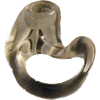Sound Bores
Horn Effects
Acoustic research has long shown that the high frequency component of any acousticsignal can be reduced if the sound outlet is reduced, and enhanced if the sound outlet is expanded. This is the essence of Horn Theory. This plays a particularly important role in current hearind aid dispensing practice since many of the newer hearing instruments are capable of reproducing the high frequency signals out to 7000-9000 Hz. If the tube and earmold restrict the resonances in the sound channel, the tube and earmold will cut off high frequencies. Thus , in many fittings a “horn” of some type will be essential. The reduced sound outlet in earmolds is referred to as “reverse horn.” This would be indicated in those clients whose audiograms slope upwards in the higher frequencies.Horn effects to increase high frequencies can be achieved by using a drilled horn bore, large bore, reverse curve bore, and high frequency bore. These bores are drilled into the earmold according to the physical characteristics of the ear canal.
Standard Bore is a 2mm drilled bore to accomodate #13 tubing to the tip of the ear canal of the mold.

Horn Bore is a 3mm of 4mm drilled bore opened half way down the ear canal of the mold then narrows to a 2mm bore to accomodate #13 tubing. The tubing is inserted just to where the bore begins to open, this gives the horn effect.

Large Bore is used when the physical characteristics of the ear canal are too small to accomodate a drilled 3mm or 4mm horn bore. The bore is horned to the size of the ear canl then tubed the same as the horn bore.

Reverse Curve Bore is used when the hearing loss is more dominant in the low frequencies than the high frequencies. When the hearing loss is in the lows in the moderate range, a parallel vent should be used. The bore is drilled the opposite of a horn or large bore. A 1.5 mm drill bit is used to drill half way down the ear canal into a large 2mm bore to accomodate #13 tubing. Reverse curve bores are also used in severe to profound hearing loss when feedback is a problem.

High Frequency Bore is used with precipiitous ski slope loss whenthe hearing loss is normal to mild in the lows then becomes more severe after 1000Hz. The high frequency bore is used with a short or medium canal length. The bore is opened as large as possible preserving Natural Ear Canal Resonance. The tubing will be inserted only a 1/4″ into the bore to accommodate the cavity of the high frequency bore. The high frequency bore is usually complimented with an S.A.V. or with both a drilled medium vent and pressure vents.

